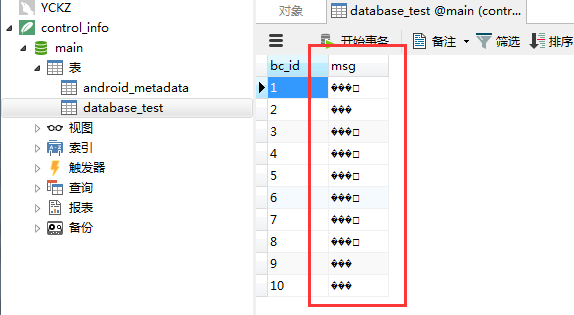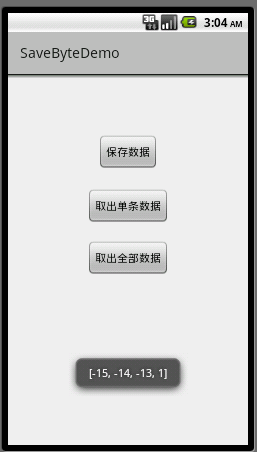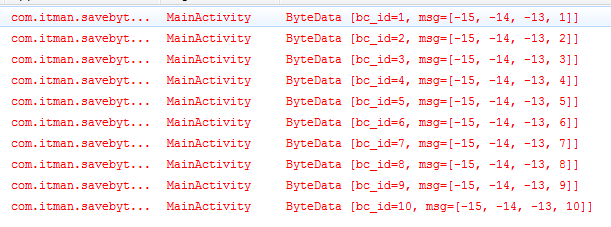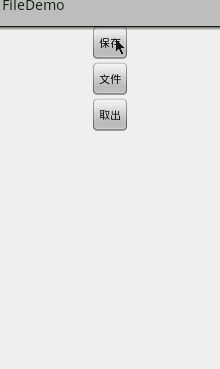近几天需要实现了一个需求,需要存取不定长度的数组。
Android的文件存取是可以实现的,但是有点麻烦,方便使用的话就只能一个数组存取在一个文件里面,万一数组多了起来,同样的文件也多了起来。再者文件的名称也不好管理。
于是乎就想到了sqlite,但是之前学习的sqlite数据库并没有存储类型适合存取不定长的数组的。后来一查,结果还有一个Blob类型,Blob类型是二进制大对象,是一个可以存储二进制文件的容器。有兴趣的可以自行去查。
由于有这个Blob类型,那么sqlite就可以存取图片(图片转换成byte数组)、对象(对象序列化之后)和各种byte数组了。
不会使用sqlite参考之前的博客
Android数据存储(二)—Sqlite数据库(上)
Android数据存储(二)—Sqlite数据库(下)
这里就不多说sqlite的使用了,直接演示一个简单的byte存取的案例。
创建一个Android项目,然后新建一个DataSQLiteHelper继承SQLiteOpenHelper:
import android.content.Context;
import android.database.sqlite.SQLiteDatabase;
import android.database.sqlite.SQLiteDatabase.CursorFactory;
import android.database.sqlite.SQLiteOpenHelper;
/**
* Created by Layne_Yao on 2017-8-16
* CSDN:http://blog.csdn.net/Jsagacity
*/
public class DataSQLiteHelper extends SQLiteOpenHelper {
public DataSQLiteHelper(Context context, String name,
CursorFactory factory, int version) {
super(context, name, factory, version);
}
public DataSQLiteHelper(Context context) {
super(context, "control_info.db", null, 1);
}
/**
* 当数据库创建时回调的函数
*
* @param db
*/
@Override
public void onCreate(SQLiteDatabase db) {
String table_one_sql = "create table database_test (bc_id Integer primary key,msg Blob)";
db.execSQL(table_one_sql);// 执行sql语句
}
/**
* 当数据库版本更新时回调的函数
*
* @param db
* @param oldVersion
* @param newVersion
*/
@Override
public void onUpgrade(SQLiteDatabase db, int oldVersion, int newVersion) {
}
/**
* 当数据库打开是回调的函数
*
* @param db
*/
@Override
public void onOpen(SQLiteDatabase db) {
super.onOpen(db);
}
}再来一个数据库的管理类:
import android.content.ContentValues;
import android.database.Cursor;
import android.database.sqlite.SQLiteDatabase;
import java.util.ArrayList;
import java.util.List;
import com.itman.savebytedemo.ByteData;
/**
* Created by Layne_Yao on 2017-8-16
* CSDN:http://blog.csdn.net/Jsagacity
*/
public class DbManger {
private static SQLiteDatabase db;
public static void setDb(SQLiteDatabase db) {
DbManger.db = db;
}
public static void closeSQLiteDatabase() {
db.close();
}
/**
* 将Cursor内的数据转换成对象存放在List中
*/
public static List<ByteData> cursorToList(Cursor cursor) {
List<ByteData> list = new ArrayList<>();
ByteData byteData;
while (cursor.moveToNext()) {
int bc_id = cursor.getInt(cursor.getColumnIndex("bc_id"));
byte[] msg = cursor.getBlob(cursor.getColumnIndex("msg"));
byteData = new ByteData(bc_id, msg);
list.add(byteData);
}
return list;
}
public static boolean addData(int bc_id, byte[] msg) {
ContentValues values = new ContentValues();
values.put("bc_id", bc_id);
values.put("msg", msg);
long result = db.insert("database_test", null, values);
if (result > 0) {
return true;
} else {
return false;
}
}
/**
* 查询所有
*
* @return
*/
public static List<ByteData> selectAllData() {
Cursor cursor = db.query("database_test", null, null, null, null, null,
null);
List<ByteData> list = cursorToList(cursor);
return list;
}
/**
* 根据Id查询数据
*
* @return
*/
public static byte[] selectData(int bc_id) {
/**
* api查询方式 query(String table, String[] columns, String selection,String[] selectionArgs, String groupBy, String having,String orderBy)
* String table 表示查询的表名
* String[] columns表示查询表中的字段名称 null查询所有
* String selection 表示查询条件
* where 子句
* String[] selectionArgs 表示查询条件的占位符取值
* String groupBy 表示分组条件
* group by 子句
* String having 表示筛选条件
* having 子句
* String orderBy 表示排序条件
* order by 子句
*/
Cursor cursor = db.query("database_test", null, "bc_id = ?",
new String[] { bc_id + "" }, null, null, null, null);
cursor.moveToNext();
byte[] msg = cursor.getBlob(cursor.getColumnIndex("msg"));
return msg;
}
}数据库管理类中使用了一个bean对象,这里给补上:
import java.util.Arrays;
/**
* Created by Layne_Yao on 2017-12-14 上午10:03:02.
* CSDN:http://blog.csdn.net/Jsagacity
*/
public class ByteData {
private int bc_id;
private byte[] msg;
public ByteData(int bc_id, byte[] msg) {
this.bc_id = bc_id;
this.msg = msg;
}
public int getBc_id() {
return bc_id;
}
public void setBc_id(int bc_id) {
this.bc_id = bc_id;
}
public byte[] getMsg() {
return msg;
}
public void setMsg(byte[] msg) {
this.msg = msg;
}
@Override
public String toString() {
return "ByteData [bc_id=" + bc_id + ", msg=" + Arrays.toString(msg)
+ "]";
}
}布局文件三个按钮就够了:
<RelativeLayout xmlns:android="http://schemas.android.com/apk/res/android"
xmlns:tools="http://schemas.android.com/tools"
android:layout_width="match_parent"
android:layout_height="match_parent"
tools:context="com.itman.savebytedemo.MainActivity" >
<Button
android:id="@+id/bt_save"
android:layout_width="wrap_content"
android:layout_height="wrap_content"
android:layout_alignParentTop="true"
android:layout_centerHorizontal="true"
android:layout_marginTop="81dp"
android:text="保存数据" />
<Button
android:id="@+id/bt_get"
android:layout_width="wrap_content"
android:layout_height="wrap_content"
android:layout_below="@+id/bt_save"
android:layout_centerHorizontal="true"
android:layout_marginTop="24dp"
android:text="取出单条数据" />
<Button
android:id="@+id/bt_get_all"
android:layout_width="wrap_content"
android:layout_height="wrap_content"
android:layout_centerHorizontal="true"
android:layout_centerVertical="true"
android:text="取出全部数据" />
</RelativeLayout>最后就是MainActivity类了:
public class MainActivity extends ActionBarActivity implements OnClickListener {
private Button bt_save, bt_get, bt_get_all;
@Override
protected void onCreate(Bundle savedInstanceState) {
super.onCreate(savedInstanceState);
setContentView(R.layout.activity_main);
InitView();
InitSQLiteDatabase();
}
private void InitView() {
bt_save = (Button) findViewById(R.id.bt_save);
bt_get = (Button) findViewById(R.id.bt_get);
bt_get_all = (Button) findViewById(R.id.bt_get_all);
bt_save.setOnClickListener(this);
bt_get.setOnClickListener(this);
bt_get_all.setOnClickListener(this);
}
/**
* 实例化一个数据库操作对象传递给DbManger
*/
private void InitSQLiteDatabase() {
DataSQLiteHelper helper = new DataSQLiteHelper(MainActivity.this);
SQLiteDatabase db = helper.getWritableDatabase();
DbManger.setDb(db);
}
@Override
public void onClick(View v) {
switch (v.getId()) {
case R.id.bt_save:
byte[] msg;
for (int i = 1; i < 11; i++) {
msg = new byte[] { (byte) 0xf1, (byte) 0xf2, (byte) 0xf3,
(byte) i };
DbManger.addData(i, msg);
}
break;
case R.id.bt_get:
byte[] msg_byte = DbManger.selectData(1);
Toast.makeText(this, Arrays.toString(msg_byte), Toast.LENGTH_SHORT)
.show();
break;
case R.id.bt_get_all:
List<ByteData> list_byteData = DbManger.selectAllData();
for (int i = 0; i < list_byteData.size(); i++) {
Log.e("MainActivity", list_byteData.get(i).toString());
}
break;
}
}
}运行结果,先点击保存数据,取出单条数据:
取出全部数据:
再将项目里面的数据库导出来,放在Navicat中查看,存储byte数组列看起来是乱码,很正常,它没办法给你形象的显示数组数据,所以最简单的就是乱码显示。我们能够正常的进行存取就行了:

文件存储byte数组
接下来实现将byte数组存储到文件里面,也是非常简单的,就直接演示代码,管理文件类代码:
/**
* Created by Layne_Yao on 2017-12-19 下午5:17:22.
* CSDN:http://blog.csdn.net/Jsagacity
*/
public class FileUtils {
/**
* 创建文件并存储数据
* byte[] bytes 要存储的数据
* StringBuilder str 文件名称
*/
public static void createFileWithByte(Context context,byte[] bytes, StringBuilder str) {
/**
* 创建File对象,其中包含文件所在的目录以及文件的命名
*/
File file = new File(context.getFilesDir(), str.append(".txt").toString());
// 创建FileOutputStream对象
FileOutputStream outputStream = null;
try {
// 如果文件存在则删除
if (file.exists()) {
file.delete();
}
// 获取FileOutputStream对象
outputStream = new FileOutputStream(file);
// 获取BufferedOutputStream对象
// 往文件所在的缓冲输出流中写byte数据
outputStream.write(bytes);
// 刷出缓冲输出流,该步很关键,要是不执行flush()方法,那么文件的内容是空的。
} catch (Exception e) {
// 打印异常信息
e.printStackTrace();
} finally {
// 关闭创建的流对象
if (outputStream != null) {
try {
outputStream.close();
} catch (IOException e) {
e.printStackTrace();
}
}
}
}
/**
* 取出制定文件的数据
*/
public static byte[] readFileWithByte(Context context,StringBuilder str) {
byte[] light = new byte[10];
File file = new File(context.getFilesDir(), str.append(".txt").toString());
// 创建FileOutputStream对象
FileInputStream inputStream = null;
try {
inputStream = new FileInputStream(file);
inputStream.read(light);
} catch (FileNotFoundException e) {
e.printStackTrace();
} catch (IOException e) {
e.printStackTrace();
} finally {
// 关闭创建的流对象
if (inputStream != null) {
try {
inputStream.close();
} catch (IOException e) {
e.printStackTrace();
}
}
}
return light;
}
}布局同样的三个按钮的事:
<RelativeLayout xmlns:android="http://schemas.android.com/apk/res/android"
xmlns:tools="http://schemas.android.com/tools"
android:layout_width="match_parent"
android:layout_height="match_parent"
tools:context="com.itman.filedemo.MainActivity" >
<Button
android:id="@+id/bt_save"
android:layout_width="wrap_content"
android:layout_height="wrap_content"
android:layout_alignLeft="@+id/bt_show"
android:layout_alignParentTop="true"
android:text="保存" />
<Button
android:id="@+id/bt_show"
android:layout_width="wrap_content"
android:layout_height="wrap_content"
android:layout_below="@+id/bt_show_dou"
android:layout_centerHorizontal="true"
android:text="取出" />
<Button
android:id="@+id/bt_show_dou"
android:layout_width="wrap_content"
android:layout_height="wrap_content"
android:layout_alignLeft="@+id/bt_save"
android:layout_below="@+id/bt_save"
android:text="文件" />
</RelativeLayout>MainActivity的代码:
import java.io.File;
import java.util.Arrays;
import android.os.Bundle;
import android.support.v7.app.ActionBarActivity;
import android.view.View;
import android.view.View.OnClickListener;
import android.widget.Button;
import android.widget.Toast;
public class MainActivity extends ActionBarActivity implements OnClickListener {
private Button bt_save;
private Button bt_show;
private Button bt_show_dou;
@Override
protected void onCreate(Bundle savedInstanceState) {
super.onCreate(savedInstanceState);
setContentView(R.layout.activity_main);
bt_save = (Button) findViewById(R.id.bt_save);
bt_show = (Button) findViewById(R.id.bt_show);
bt_show_dou = (Button) findViewById(R.id.bt_show_dou);
bt_save.setOnClickListener(this);
bt_show.setOnClickListener(this);
bt_show_dou.setOnClickListener(this);
}
@Override
public void onClick(View v) {
switch (v.getId()) {
case R.id.bt_save:
byte[] light_code = new byte[] { 1, 2, 3, 4, 5, 6, 7, 8, 9, 10 };
FileUtils.createFileWithByte(this,light_code, new StringBuilder("file"));
break;
case R.id.bt_show:
Toast.makeText(
this,
Arrays.toString(FileUtils.readFileWithByte(this,new StringBuilder("file"))),
Toast.LENGTH_SHORT).show();
break;
case R.id.bt_show_dou:
//显示文件名
show();
break;
}
}
private void show() {
File file = new File(getBaseContext().getFilesDir().toString());
String[] name = file.list();
Toast.makeText(this, Arrays.toString(name), Toast.LENGTH_SHORT).show();
}
}运行结果:
如果取出存储的文件,查看文件里面的数据也是乱码的。
这样的需求sqlite可以实现,那么MySQL也是可以实现的。同样的文件也可以存储byte数组,以上就是全部的代码了,没必要提供源代码了。很简单的。



























 6599
6599

 被折叠的 条评论
为什么被折叠?
被折叠的 条评论
为什么被折叠?








